Brigitte Bardot – Cinema’s First Liberated Woman
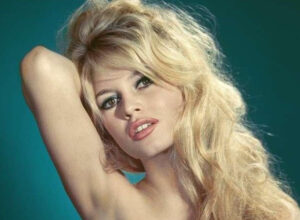
“Bardot emerged in 1956 in “And God Created Woman”. It was a shock equal to Boticelli’s “The Birth of Venus”. (…) She was neither vamp nor star, neither myth nor mystery. She brought a provocative sincerity, a naive perversity, and above all indifference to sin. (…) She is an anti-vamp and even an anti-star, because she refused (she was by her very nature incapable of doing so) to put on any kind of uniform, to create a concrete figure. – This is what Guy Braucourt wrote about Bardot.
Brigitte Bardot was born in 1934 in Paris. She came from a wealthy home with strict rules, her father was an engineer and entrepreneur and, together with her mother, took great care in raising their daughters. Bardot attended ballet school from childhood, and as a teenager she did modeling for several famous fashion magazines. Thanks to this, she was noticed by a young director, Roger Vadim, who saw in Bardot the symbol of his generation – a natural girl, without restraint exposing her own eroticism. Vadim and Bardot soon became a couple, and Bardot began playing episodic roles in French films.
Brigitte Bardot – provocatively shameless, beautiful and free
In 1952, the actress became the wife of Vadim, who had his own idea for her (See more: Brigitte Bardot & Roger Vadim). Brigitte, through various cosmetic procedures, gradually gained her unique image, which later became her trademark. Brigitte began to appear in subsequent films, such as “The Girl in the Bikini” (1953),”Helen of Troy” (1955) or closer to her later creations: “The Light Across the Street”, “Naughty Girl”, “Plucking the Daisy”.
The real success, however, turned out to be Roger Vadim’s film “And God Created Woman” (1956). Undoubtedly, Bardot’s role in this work opened a new stage in the history of cinema. The actress appeared in Vadim’s film changed and unique, and the heroine created by her was to determine the way Bardot herself was perceived for the next twenty years. So what was the originality of the French star?
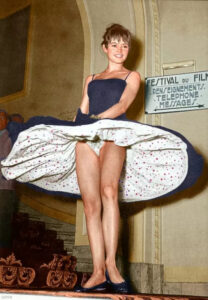
Well, she created a completely different image of femininity than the one presented by the femme fatale actresses who preceded her. Unlike Greta Garbo, Marlene Dietrich or Marilyn Monroe, Bardot did not appear on screen with an elaborate hairdo, impeccable makeup and evening gown. Brigitte in the first scene of “And God Created Woman” presented herself… naked, in all her glory. Juliette Hardy, the heroine of Vadim’s film, is seen sunbathing without restraint on a terrace, her body covered only by drying sheets.
Brigitte with windswept hair, in a summer beach dress, barefoot, natural and incredibly sensual at the same time – this was the new cinema icon. The story of a young girl, nineteen years old, who freely romances three men and finally chooses not the wealthiest one, although the plot is quite simple, was a new discovery for the cinema. Here appeared a new type of heroine – aware of her own sexuality, liberated and immoral. The new wave film was a harbinger of the coming generation and a different morality.
The leading representative of the second wave of feminism, Simone de Beauvoir, the author of “The Second Sex”, wrote about Bardot, seeing in her a symbol of the sexual equality of women. It was indeed Bardot who became the voice of female eroticism, which for the first time so openly entered the screens and almost demanded recognition for itself on the same terms as male lust. The quintessence of this sensuality was the famous scene of Bardot dancing in a nightclub in Saint-Tropez.
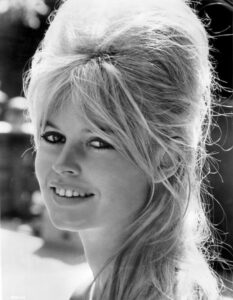
Bardot – an icon of rebellion and youth
The film “And God Created Woman” actually ended the marriage of Bardot and Vadim; the divorce was finalized in 1957. Meanwhile, the actress stood at the threshold of her great fame, which quickly crossed the borders of the old continent. Of course, the French star enjoyed special popularity in the United States. The importance of Bardot, as a representative of the younger generation, de Beauvoir compared to James Dean, an American icon of youth and rebellion.
Subsequent films starring Bardot solidified the actress’s position and, at the same time, her ambivalent perception. She starred in “La Parisienne” and in “The Night Heaven Fell” (1957) she again played a woman openly engaging in erotic relationships. In the former, she played the role of a prime minister’s daughter who romances the husband of the queen of another country. The myth of the amoral girl also became the basis of the film “In Case of Adevrsity” (1958), directed by Claude Autant-Lara. Bardot played the unprincipled Yvette, ruthlessly exploiting men and driving an older, married lawyer to his doom. Bardot’s partner here was Jean Gabin himself, and the role was a great success for the actress.
Bardot’s “improvement”
A slightly different image of Bardot emerged from her next film, the 1959 comedy “Babette Goes to War”. It is the story of a courageous French girl who is active in the resistance and performs heroic deeds. In the eyes of the audience, this screen “improvement” was followed by the star’s settling down in her private life, as Bardot, after numerous romances, married Jacques Charrier and gave birth to a son.
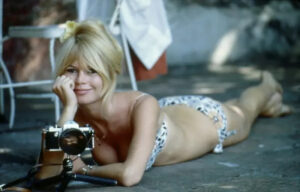
Bardot in “Viva Maria!”
Nevertheless, Bardot’s transformation soon proved to be short-lived. She was unable to enjoy motherhood and put her son in the care of her husband’s family, with whom she soon divorced. She also did not break her screen image of the embodiment of wild lust. Her subsequent films again bring the image of the naughty Bardot, a woman-lolita, who with her innate charm and animal predation reaches for what she desires. She appears in such a role, for example, in “The Truth” (1960).
Brigitte Bardot – muse to the directors of the French New Wave
Bardot managed to prove in “The Truth” that she had a talent for drama. The famous directors of the French New Wave began to seek her involvement. Louis Malle’s film, “A Very Private Affair”, promised to be very interesting, as the actress played herself here. The story of a movie star harassed by crowds of fans and journalists, ending with her accidental death, was supposed to reveal the truth about Brigitte Bardot herself. However, this intention failed because it was just another role and not an explanation of the mechanism of star creation itself.
Another great director who engaged Bardot was Jean-Luc Godard. In 1963, the actress starred in his film “Contempt”. She played Camilla, the director’s wife, who loses respect for her husband who values money more than fidelity to art and leaves him.
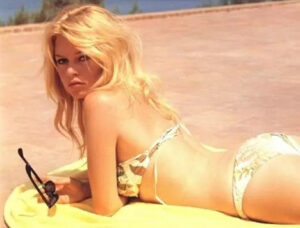
Brigitte Bardot in “Contempt”
Recent successes and the end of the myth of the eternally young BB
In the 1960s, the comedy with Brigitte Bardot Viva Maria! Mallea’s. Her film partner became another famous star of French cinema, Jeanne Moreau. The film is set in the early 20th century in the fictional republic of Mexico, San Miguel. Women earning money mainly from the stripped-down performances of the French traveling theater unexpectedly become leaders of the revolution. The film was a great success especially in America, where Bardot went for promotional purposes. However, the USA did not delight BB, in New York she was terrified by the crowd marching behind her, so the star spent most of her time in a hotel room.
In 1966, Bardot once again married, she married millionaire Gunter Sachs. Her next roles were no longer received with acclaim by either critics or audiences. In the film “Shalako” (1968) she played the role of a countess from Eastern Europe who settles in the Wild West. The western satire Queens of the Wild West (1971), in which Bardot co-starred with Italian diva Claudia Cardinale, was also not a success. The film If Don Juan Was a Woman, after which the critics did not leave a dry thread on BB, turned out to be a complete disaster.
So the star finally left the cinema with her last film in 1973, at the age of 40. The reason for the end of her stunning career was the fact that she had not undergone any artistic evolution – for 20 years she had played almost the same character over and over again – a brooding nymphet rebelling against bourgeois morality. Unfortunately, she could not be credible in this role for such a long period of time. Not only did Bardot herself change, as she became a mature woman, but also the era changed – the sexual revolution became a fact.
BB withdrew from public life, today we know her mainly for her animal protection activities. However, the myth of the eternally young Brigitte remained. What is more, many cinema experts believe that it was the last great myth of the silver screen, and BB was the last great star.
Literature:
Maria Oleksiewicz, “Bardot”, Warszawa 1979.
